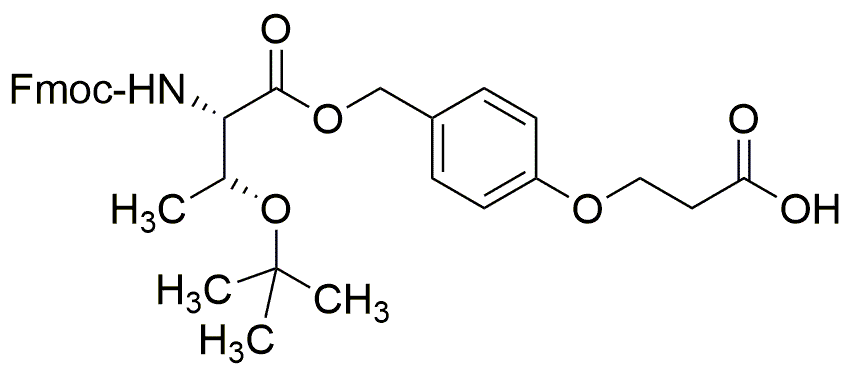Fmoc-L-Thr(tBu)-O-CH2-Ph-OCH2-CH2-COOH is widely utilized in research focused on:
- Peptide Synthesis: This compound serves as a key building block in the synthesis of peptides, enabling researchers to create complex molecules for drug development and biological studies.
- Drug Delivery Systems: Its unique structure allows for the formulation of advanced drug delivery systems, improving the bioavailability and efficacy of therapeutic agents.
- Bioconjugation: The compound is used in bioconjugation processes, facilitating the attachment of biomolecules to surfaces or other molecules, which is crucial in diagnostics and therapeutic applications.
- Research in Cancer Therapy: It plays a role in developing targeted therapies for cancer, where its properties help in designing compounds that can selectively deliver drugs to tumor cells.
- Protein Engineering: The compound is valuable in protein engineering, aiding in the modification of proteins to enhance their stability and functionality for various industrial and medical applications.
General Information
Properties
Safety and Regulations
Applications
Fmoc-L-Thr(tBu)-O-CH2-Ph-OCH2-CH2-COOH is widely utilized in research focused on:
- Peptide Synthesis: This compound serves as a key building block in the synthesis of peptides, enabling researchers to create complex molecules for drug development and biological studies.
- Drug Delivery Systems: Its unique structure allows for the formulation of advanced drug delivery systems, improving the bioavailability and efficacy of therapeutic agents.
- Bioconjugation: The compound is used in bioconjugation processes, facilitating the attachment of biomolecules to surfaces or other molecules, which is crucial in diagnostics and therapeutic applications.
- Research in Cancer Therapy: It plays a role in developing targeted therapies for cancer, where its properties help in designing compounds that can selectively deliver drugs to tumor cells.
- Protein Engineering: The compound is valuable in protein engineering, aiding in the modification of proteins to enhance their stability and functionality for various industrial and medical applications.
Documents
Safety Data Sheets (SDS)
The SDS provides comprehensive safety information on handling, storage, and disposal of the product.
Product Specification (PS)
The PS provides a comprehensive breakdown of the product’s properties, including chemical composition, physical state, purity, and storage requirements. It also details acceptable quality ranges and the product's intended applications.
Certificates of Analysis (COA)
Search for Certificates of Analysis (COA) by entering the products Lot Number. Lot and Batch Numbers can be found on a product’s label following the words ‘Lot’ or ‘Batch’.
*Catalog Number
*Lot Number
Certificates Of Origin (COO)
This COO confirms the country where the product was manufactured, and also details the materials and components used in it and whether it is derived from natural, synthetic, or other specific sources. This certificate may be required for customs, trade, and regulatory compliance.
*Catalog Number
*Lot Number
Safety Data Sheets (SDS)
The SDS provides comprehensive safety information on handling, storage, and disposal of the product.
DownloadProduct Specification (PS)
The PS provides a comprehensive breakdown of the product’s properties, including chemical composition, physical state, purity, and storage requirements. It also details acceptable quality ranges and the product's intended applications.
DownloadCertificates of Analysis (COA)
Search for Certificates of Analysis (COA) by entering the products Lot Number. Lot and Batch Numbers can be found on a product’s label following the words ‘Lot’ or ‘Batch’.
*Catalog Number
*Lot Number
Certificates Of Origin (COO)
This COO confirms the country where the product was manufactured, and also details the materials and components used in it and whether it is derived from natural, synthetic, or other specific sources. This certificate may be required for customs, trade, and regulatory compliance.

